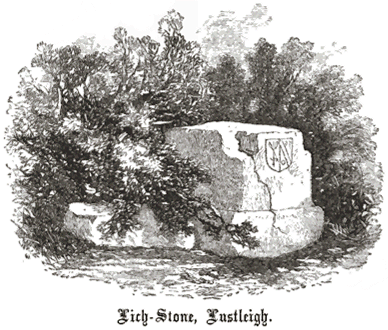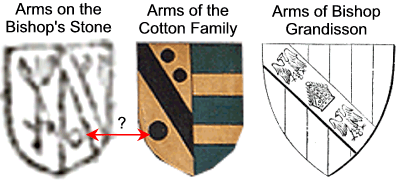
‘At Lustleigh, in Devonshire, is an octagonal Lich-Stone called Bishop’s Stone, having engraved upon it the arms of Bishop Cotton.’, (Hood, 1862, p.98).
The above is an interesting comment and refers to a huge block of granite known as The Bishop’s Stone and its location is said to be at the old entrance to Lustleigh. The only problem with this statement is that apart from the name everything else goes against modern consensus. Firstly, a Lich Stone was/is a large, low, slab of stone on which a coffin was rested prior to being escorted into the church by the vicar. The Bishop’s Stone is now located a fair distance from the church and there is no reason to believe that it stood anywhere apart from its current location. One thing Mr. Hood was kind enough to provide with his article was a sketch of the stone:

Where the confusion occurs is the fact that, according to Hood and many other writers, the coat of arms on the Bishop’s Stone are those of Bishop Cotton. William Cotton was the Bishop of Exeter from 1598 to 1621 and was noted for being confrontational when dealing wit the puritans in his flock. However, eleven years earlier in 1851 another theory as to the coat of arms had been proposed:
‘In a lane near the church is the Bishop’s Stone, a block of granite in a hedge, adjoining the road, about five feet in height; on it may be traced the form of an escutcheon; but every part, except the outline is completely obliterated… A tradition prevails, that the arms were those of Bishop Grandisson, who once passed through Lustleigh and dined off this stone. It was most probable the pedestal of a cross, being only a few paces from a cross-road.’, (Halle, 1851, p.13).
John Grandisson was Bishop of Exeter from 1327 to 1369 and during his office he came into conflict with the Augustinian monks at Frithelstock in North Devon who were promoting some cult he was adverse to. Along with this his final demise was to be beheaded by a mob in London for favouring the dispensers, (Baring Gould, 1982, p.174). So just possibly there were two bishops, both had offended various groups of people who just possibly want to deface their coats of arms??? That however, does not solve the problem as to who they belong to, if the depiction in the above sketch is enlarged and then compared with the arms of Grandisson and Cotton you get the following:

Sadly there is nothing conclusive but if anything there is a possibly similarity with the Cotton coat of arms and of course assuming the detail from the sketch is accurate? One other point that may indicate that the arms belonged to Cotton is the fact that also carved on the stone are the initials ‘T.C.’ which it has been suggested refer to one Thomas Comyn. He was the rector of Lustleigh church and was instituted into the living by Bishop Cotton in 1607, (Russell-Welch, 1989, p.14).
As noted above, one of the reasons for the stone being so-called was that Bishop Grandisson once ate a meal off the stone, hmm, why would any dignitary want to do that unless there was some symbolic purpose? If this was the case then that would indicate that the stone and/or its location served a special purpose which Crossing suggested may well have been the possibility that the stone acted as a boundary marker of some episcopal lands which would also explain its name, (Crossing, 1987, p.157).

What everybody seems to agree on is the fact that despite there being no socket hole the Bishop’s Stone was once the pedestal of an old cross, (Crossing 1987, p.157, Starkey, 1983, p.69, Sandles, 1997, p.120, etc.). An English Heritage field investigator made the following observations in 1953:
‘This is the massive base of a cross which was originally buried in the ground to a depth of 0.9m and stood 0.6m above the surface. It is now supported by a modern railing and wall because it could not stand unaided. The block is 1.1m square at its intended ground level and the top is reduced to an octagonal shape by chamfers 0.25m deep.’, (English Heritage, 2009, on-line source).
By the sheer size of the stone it can be assumed that if any cross did stand upon it then this would have been the village cross or preaching cross. There is also a tradition that when the villagers were going to make a pilgrimage to Tavistock Abbey they would all congregate at the Bishop’s Stone prior to departure for a blessing which seems perfectly reasonable. Conversely local legend has it that none of the same villagers would, if possible, ever go near the stone after dark for fear of meeting the local goblin:
‘There is said to be a goblin about a quarter of a mile from here. He sits on Bishop’s Stone so called because it bears the coat-of arms of bishop Grandisson of Exeter, 1327 to 1369 A.D. I have never seen the goblin ; but I have good evidence that men have been scared by something there at night, and that horses have refused to pass there in the day. I fancy they hear the murmur of water running underground.’, (Torr, 1918, p.13).
So there it is, a very enigmatic stone that has attached to it more questions than answers; was it once a lich stone, whose coat of arms were inscribed upon it, was it an ecclesiastical boundary stone and where has the goblin gone? If ever you are in Lustleigh why not go and visit the stone and then decide for yourself.

Baring Gould, S. 1982. A Book of Dartmoor, London: Wildwood House Ltd.
Crossing, W. 1987 The Ancient Stone Crosses of Dartmoor, Devon Books, Exeter.
English Heritage. 2009. Pastscape Record – The Bishop’s Stone, online source, see link below.
Halle, F. 1851. Letters Historical & Botanical Relating to the Valley of the Teign, London: Houlston & Stoneman.
Hood, T. 1862. Stones of the Temple – Lich Stones, Church Builder No.3, London: Rivingtons.
Russell Welch, M. 1989. Lustleigh Guide, Lustleigh: The Parish Council.
Sandles, T. 1997. A Pilgrimage to Dartmoor’s Crosses, Liverton: Forest Publishing.
Starkey, F. H. 1983. Dartmoor Crosses and Some Ancient Tracks, Privately Published.
Torr, C. 1918. Small Talk at Wreyland, Cambridge: University Press.
![]()
Pastscape Record – HERE
 Legendary Dartmoor The many aspects past and present of Dartmoor
Legendary Dartmoor The many aspects past and present of Dartmoor

One comment
Pingback: Walking the Dartmoor Fringe: Pullabrook to Lustleigh - Moor & More Images